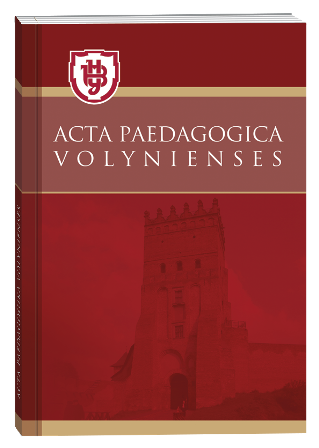COMPARATIVE ANALYSIS OF THE FEATURES OF THE FORMATION OF THE SYNERGETIC COMPONENT OF THE CREATIVE ACTIVITY OF ADOLESCENTS WITH VISUAL IMPAIRMENTS AND WITH NORMAL VISION
DOI:
https://doi.org/10.32782/apv/2021.3.34Keywords:
creative activity, synergistic component, adolescents, visual impairments, empathyAbstract
The study involved 130 respondents, including 111 adolescents (68 adolescents with visual impairments (EG1);
43 of their peers with normal vision (EG2) and 19 teachers (10 – from secondary schools and 9 – from special secondary
schools) who perform the role of class teachers of those adolescents with visual impairments and with normal vision who
became the respondents of our study.
Purpose: to implement a comparative analysis of the features of the formation of the synergistic component
of the individual creative activity of the adolescents with visual impairments and with normal vision.
This study was implemented using the personality-oriented approach. To ensure the reliability of the results
and conclusions, and achieve the goal of the study, a set of methods was used. Among theoretical methods were used
next ones: deductive – for a systematic description of the phenomenon under study and inductive – to establish patterns,
their systematization on the basis of the results obtained in the empirical part of the study. Among empirical methods:
a statement experiment using two psychodiagnostic techniques to diagnose the synergistic component of the creative
activity of adolescents with visual impairments and with normal vision.
For the first time, in this study was represented a comparative analysis of the peculiarities of the formation
of the synergetic component of creative activity of adolescents with visual impairments relative to their peers without
visual impairments. The scientific research about general empathic tendency in the specified category of teenagers is
confirmed and deepened. The study of the peculiarities of personal development of adolescents with visual impairments in
the context of the formation of their creative activity was further developed.
The results of the study give grounds to conclude that it is necessary to work purposefully on the formation of a synergistic
component of creative activity of adolescents with visual impairments. Prospects for future research will be aimed at developing
and testing pedagogical technology for the formation of creative activity of this category of adolescents.
References
Root-Bernstein R., Root-Bernstein M. Life Stages of Creativity. Encyclopedia of Creativity / Eds. M.A. Runco, S.R. Pritzker. Second edition. Vol. 2. San Diego : Academic Press, 2011. P. 47–55.
Runco M.A. Development of Creativity. International Encyclopedia of Education. Third Edition. University of Georgia, GA, USA, 2010. P. 251–254.
Russ S.W., Christian K.M. Play. Encyclopedia of Creativity. Second Edition. 2011. P. 360–366.
Woodel-Johnson B.L., Delcourt M., Treffinger D.J. Relationships between creative thinking and problem solving styles among secondary school students. The International Journal of Creativity & Problem Solving. 2012. Vol. 22 (2). P. 79–95.
Wei Zhang, Weihua Niu. Creativity in the later life: factors associated with the creativity of the Chinese elderly. The Journal of creative behavior. 2013. Vol. 47 (1). P. 60–76.
Виноградова В.Є. Вплив середовища на розвиток особистості та її творчих здібностей. Теорія і практика сучасної психології. 2019. № 3. Т. 1. С. 28–32.
Goltsman S.M. (2002). Recreation and Play Environments. Clinician`s Guide to Assossiate Technology. 2002. P. 451–469.
Kohanyi A. Families and Creativity. Encyclopedia of Creativity. Second Edition. 2011. P. 503–508.
Кобильченко В.В. Соціально-психологічні основи розвитку та корекції особистості підлітка в нормі та при патології зору : монографія. Київ : Освіта України, 2010. 201 с.
Rhodes M. An analysis of creativity. The Phi Delta Kappan. 1961. Vol. 42. No. 7. P. 305–310.
Amabile T.M. Componential theory of creativity. Harvard Business School. Encyclopedia of Management Theory / Ed. Eric H. Kessler. Sage Publications, 2013. Working paper. URL: https://www.hbs.edu/faculty/Publication%20Files/12-096.pdf.
Amabile T.M. The social psychology of creativity: A componential conceptualization. Journal of Personality and Social Psychology. 1983. No. 45 (2). P. 357–376.
Optimal experience: Psychological studies of flow in consciousness / Eds. M. Csikszentmihalyi, I.S. Csikszentmihalyi. Cambridge University Press, 1992. 432 p.
Bohm D. On creativity. Second Edition. Routledge, 2004. 192 p.
Grabarz M., Necka E. Creativity and Cognitive Control: Explorations of Generation and Evaluation Skills. Creativity Research Journal. 2003. Vol. 15. P. 183–197.
Osborn A.F. Applied imagination. New York : Sckibner’s Sons, 1953. 317 p.
Stein M.I. Creativity and culture. The Journal of Psychology. 1953. Vol. 36. P. 311–322.
Пиаже Ж. Психология интеллекта. Санкт-Петербург : Питер, 2003. С. 12–23.
Матюх Т.М. Емпатія як умова людської творчості. Антропологічні виміри філософських досліджень. Дніпропетровськ. 2015. Вип. 7. С. 17–24.
Меграбян А., Епштейн Н. Шкала емоційного відгуку : опитувальник методики. Психологіс. Енциклопедія практичної психології. URL: http://psychologis.com.ua/oprosnik_metodiki_shkala_emocionalnogo_otklika_a._megrabyana_i_n._epshteyna.htm.
Джонсон. Д. Опитувальник креативності : тести. С. 49–52. URL: https://docs.google.com/document/d/1DoQwrmUYgF_lT243NR7qa_dDD2euRmPEYfyy5MhnNw/edit.
Ali Yildiz M., Duy Baki. Improving Empathy and Communication Skills of Visually Impaired Early Adolescents through a Psychoeducation Program. EducationalSciences: Theory & Practice. 2013. No. 13 (3). P. 1474.
Кобильченко В.В., Омельченко І.М. Спеціальна психологія. Київ : ВЦ Академія, 2020. 224 с.
Синьова Є.П. Тифлопсихологія : підручник. Київ : Знання, 2008. 365 с.
López-Justicia M. Carmen Pichardo-Martinez, Amerzcua J.A., Fernández E. The self-concepts of Spanish children and adolescents with low vision and their sighted peers. Journal of Visual Impairment & Blindness. 2001. No. 95 (3). P. 150–160.
Никулина И.Н. Развитие самооценки школьников с нарушениями зрения : учебно-методическое пособие. Санкт-Петербург : Каро, 2008. 192 с.







